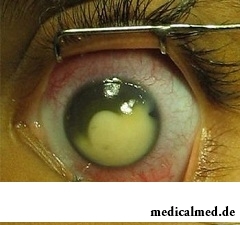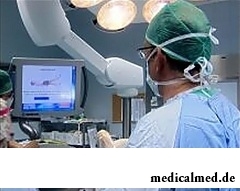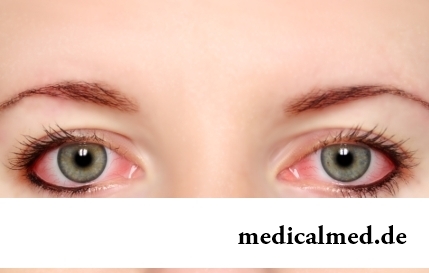





Retinoblastoma

The malignant tumor of a mesh cover of an eye – a retinoblastoma, has a neuroectodermal origin and concerns to group of hereditary diseases. It is transferred to children from parents on autosomal dominantly type.
Today the number of cases of a retinoblastoma at children considerably increased. For comparison: on official medical statistics twenty years ago the retinoblastoma was diagnosed for children in 1 case on 30 thousand living newborns, today this indicator makes 1 case on 10-15 thousand.
The Retinoblastny tumor can be formed on any site of a retina. At an initial stage the new growth is shown by the broken eyeground clearness reflex. In the following stage of growth of a retinoblastoma flat muddy education with indistinct contours forms. Further development of a tumor depends on its type and the overall clinical picture of a disease.
Types of a retinoblastoma
As distribution in fabrics specialists subdivide 2 stages of a disease of a retinoblastoma:
1. Stage of endophytic growth (intraocular). At this stage of a disease the malignant tumor expands in an eyeglobe. Growth of a tumor is followed by increase in pressure in an eye, emergence of glaucoma, and sometimes and approach of a total blindness. The patient feels pain, dizziness, nausea, periodically there are emetic desires, in some cases persistent anorexia can be created.
2. Stage of exophytic growth (extraocular). At this stage of a disease malignant growth is not limited to eyeglobe space. Getting to intracranial area on an optic nerve, tumor cells extend on the central nervous system, metastasises take lymph nodes.
On one eye tumoral growth two above described types at the same time can be diagnosed at once.
There is also a division of a retinoblastoma on a disease etiology:
1. Hereditary retinoblastoma. The most widespread type of a disease (more than 70 percent of all cases). As a rule, the retinoblastoma at children is combined with other multiple inborn malformations – heart diseases, a cortical hyperostosis, a crevice of a soft palate etc. Extremely bystry development is characteristic of a hereditary retinoblastoma, the malignant tumor forms at the same time on two eyeglobes.
In most cases this type of a retinoblastoma comes to light at early age of the child (up to 30 months).
2. Sporadic retinoblastoma. Meets much less often. Forecasts concerning this type of a disease more favorable. At a sporadic retinoblastoma one eye is surprised, the new growth forms locally, i.e. one tumoral node (a unilateral tumor) is formed. The retinoblastoma of a sporadic form can be shown at later age.
Retinoblastoma reasons
Unfortunately, the reasons of emergence of a retinoblastoma still are thoroughly not established today (if this is not about hereditary cases of this disease). The unfavourable tendency to increase in number of diseases of a retinoblastoma obviously demonstrates negative impact of a modern ecological situation, poor quality of the food stuffs consumed by the majority causing genovariations at a pre-natal stage of fetation.
Retinoblastoma symptoms

The disease of rinoblastomy is followed by the following symptoms:
- reddening of eyes;
- pain syndrome;
- mydriatic pupils;
- partial or total loss of sight;
- sometimes squint;
- at later stage the leykokoriya – literally designates "a white eye" (a pupillary reflex not red as has to be, and white).
Diagnosis of a retinoblastoma
Diagnosing of a retinoblastoma is carried out in the conditions of a specialized hospital. Taking into account early age of patients retiblastomy all diagnostic actions and procedures are carried out under the general anesthesia. As a rule, physicians prefer not to take cytologic and histologic samples of sick fabrics as during an intake of material there is extremely high risk of tool transfer of cells of innidiation.
For diagnosis of a retinoblastoma the next obligatory researches are conducted:
- computer tomography of a brain, orbit of eyes, eyeglobes;
- ekhografiya;
- X-ray analysis;
- two-projective ultrasonic inspection of eyes;
- MRT (magnetic and resonant tomography).
As additional diagnostic methods can be used:
- marrow puncture;
- puncture of a spinal cord;
- radio isotope research of bones (osteostsintigrafiya).
Treatment of a retinoblastoma

Tactics of treatment of a retinoblastoma depends on the general clinical assessment of a condition of the patient, and also on a stage of formation of tumoral process.
Specialists subdivide retinoblastoma stages according to the following severity:
- 1 stage (tumoral education is limited to retina limits);
- The 2nd stage (tumoral education is limited to eyeglobe limits);
- 3rd stage (extraocular);
- The 4th stage (the metastasis is characterized by the remote distribution).
After definition of severity of a disease of a retinoblastoma the following medical events are used:
1. Surgery. Treats a last resort, it is applied at absolute loss of visual functions and utter impossibility of their recovery. As complex treatment chemical and beam therapies are appointed.
2. A cryolysis – therapy by low temperatures at a retinoblastoma of an easy stage of the front site of a retina.
3. Photocoagulation method. Use of laser beams renders good therapeutic effect at treatment of a retinoblastoma of an easy stage of the back site of a retina.
4. Thermotherapy (complex use of microwave therapy, infrared and ultrasonic radiation).
During sneezing our organism completely stops working. Even heart stops.

Sometimes it seems that modern society was divided into two camps: representatives of the first are sure that has to for contraception отвеч...
Section: Articles about health
The winter swimming in open reservoirs called in our country by "winter swimming" – officially recognized sport and one of the most extreme ways of a hardening of an organism. This occupation has an old story and adherents in many countries. Are annually carried out...
Section: Articles about health
Quite large number of people adheres to the principles of vegetarian food. But how to be if in a family of vegetarians there are children? Whether it is possible to eat also it the same as to parents, or after all the children's organism is not adapted for the use of exclusively vegetable food? Let's try to understand....
Section: Articles about health
About 10-15 years ago existence of the computer in the apartment of the Russian was considered as a rarity and office rooms were only on перв...
Section: Articles about health
The summer of this year in Russia was very ambiguous. Regions suffered from a merciless heat, from pouring rains, the hail from time to time dropped out, then there was again a heat which alternated with rainfall again. Many people suffer from such sharp changes of weather...
Section: Articles about health
The mankind knows that some toxins at intake in the minimum quantities have therapeutic effect from an extreme antiquity. Many substances recognized poisonous are applied in the medical purposes also today, being the main operating components of the medicines which are officially produced by pharmaceutical industry. Let's tell only about the most known of them....
Section: Articles about health
The sclera and mucous membrane of an eye are intensively supplied with blood vessels which problem - to sate nervous tissues of body to a pitata...
Section: Articles about health
Practice of hypnotic impact on consciousness of the person contains about two millennia. During this time scientists managed to learn a lot of things about a phenomenon of hypnosis and learned to facilitate a condition of the patients having heavy illnesses with its help....
Section: Articles about health
The person, as well as all other beings living on our planet feels weather changing. It is the normal meteosensitivity which is not causing to healthy people of special troubles. Meteodependence, on the contrary, is the morbid condition which is characterized by an exacerbation of chronic illnesses at change of air temperature, differences of atmospheric pressure, wind strengthening, magnetic storms and other "surprises" on which the nature is so generous. The people suffering from meteodependence have to з...
Section: Articles about health
What is in our understanding weeds? It plants which are considered to be suitable only for compost pits and feeding жи...
Section: Articles about health
Not everyone can brag of the shining Hollywood smile. Even the person who is regularly visiting the stomatologist and watching of oral cavities over health periodically has problems: enamel of teeth darkens under the influence of some products, on it I accumulate...
Section: Articles about health
Summer in the heat. Many are going to spend vacation abroad. Travelers the tender seas, rest on beaches wait, for sightseeing, campaigns on natural and cultural reserves. But, unfortunately, on vacation also problems with health can wait for us. On a foreign trip it is possible to face also diseases which not only will spoil long-awaited issue, but also will force to be treated within long months after its termination. To be insured completely from troubles of it a sort...
Section: Articles about health
Childbirth is the most important event in life of each woman. We are women we give birth to the new little man on this light. Now...
Section: Articles about health
Energy saving lamps are one of the most popular products of innovative technologies, and there is no wonder: they much more economic also are more long-lasting than usual filament lamps. At the same time there are fears that energy saving bulbs can become the reasons...
Section: Articles about health
We present to yours the TOP of the medicamentous means exerting the stimulating impact on a potentiality, i.e. on ability of the man to commission of sexual intercourse. At once it is necessary to tell that not always disturbances of erectile function can be eliminated with reception of this or that drug. The reasons of decrease in a potentiality there can be a set, from banal overfatigue before tumoral process in a small basin therefore if the man faces similar problems too often, it should turn...
Section: Articles about health
It is difficult to revaluate importance of kidneys for an organism. These bodies not only perform work on purification of blood of decomposition products and выв...
Section: Articles about health
White teeth and the Hollywood smile – a dream of many people. Long time was considered that the plaque on teeth and change of their color – destiny of those who incorrectly eat smokes and badly brushes teeth. But the paradox is available: at everything the variety of toothpastes existing today...
Section: Articles about health
Season of activity of viral infections in the heat. Everyone can get sick, but probability of this unpleasant event it is possible and it is necessary to minimize. There is a number of rules, following to which will help or to avoid absolutely infection with flu or a SARS, or to have an illness benign and without essential complications. About ways of prevention of seasonal infections the speech in this article will also go....
Section: Articles about health
The kid who was recently born is surrounded with love of adult family members and their cares without which the baby cannot exist....
Section: Articles about health
Bathing in broths of medical flowers and plants (phytobathtub) was eurysynusic since Cleopatra who is a good judge in all that concerns beauty and health. And today phytobathtubs is the simple and available means allowing not only to remove nervous N...
Section: Articles about health
Modern footwear is extremely various. It stopped being only protection for legs long ago. Today shoes, boots, barefoot persons choose not so much proceeding from their convenience and functionality how many being guided by outward, brand and an opportunity to add with them a stylish dress. At the same time, buying footwear, think of its safety a little. Meanwhile, many popular models can do essential harm to health....
Section: Articles about health
The pine is one of the most widespread plants of our woods. Its needles and pitch not without reason called by "gallipot", since ancient times испол...
Section: Articles about health
Cellulitis - very widespread cosmetic shortcoming which arises approximately at 80% of women sooner or later. Emergence it is connected with change of structure of a hypodermic fatty layer. At the same time on the surface of skin at first there are roughnesses (cambers...
Section: Articles about health
It is impossible to imagine human life in which there would be no plants. Practically in each apartment and any production room there are window plants, millions of people with pleasure are engaged in gardening and truck farming, many citizens spend free time on seasonal dachas. However we very seldom pay attention to those properties of our green pets who can make the neighbourhood with them unpleasant and even unsafe....
Section: Articles about health
Tea is loved and use almost everything. This drink has tonic properties, contains the tannins capable podavlit...
Section: Articles about health
Cystitis, or inflammation of a mucous membrane of a bladder, this very widespread disease which, owing to some features of a structure of bodies of urinogenital system, women have approximately four times more often than men. In the main risk group...
Section: Articles about health
The next flu epidemic leads to the next panic, from year to year we give in on these manipulations: professionally alarming voice of the announcer in news, reports with calculation of the died patients, an interview with people in white dressing gowns and advertizing of anti-influenza means of different degree of inefficiency. All this reminds the Hollywood movies of epidemics threatening to destroy our planet. However, there is also one more similarity to cinema: everything comes to an end well. So, how to deal with the events, not in...
Section: Articles about health
